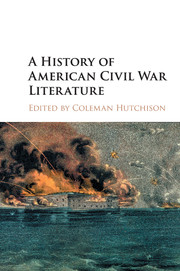Book contents
- Frontmatter
- Dedication
- Contents
- List of Illustrations
- Notes on Contributors
- Preface
- Acknowledgments
- Part I Contexts
- Part II Genres
- Part III Figures
- 12 Walt Whitman
- 13 War and the Art of Writing: Emily Dickinson's Relational Aesthetics
- 14 Herman Melville and the Civilian Author
- 15 Looking at Lincoln
- 16 Frederick Douglass, Violence, and Abraham Lincoln
- 17 Mary Boykin Chesnut: Epic and Miniature
- 18 Mark Twain
- 19 Replay: William Faulkner and the Civil War
- 20 Robert Penn Warren's Civil War
- 21 Natasha Trethewey's Civil War
- 22 Afterword: Archiving the War
- Recommendations for Further Reading
- Index
13 - War and the Art of Writing: Emily Dickinson's Relational Aesthetics
from Part III - Figures
Published online by Cambridge University Press: 05 December 2015
- Frontmatter
- Dedication
- Contents
- List of Illustrations
- Notes on Contributors
- Preface
- Acknowledgments
- Part I Contexts
- Part II Genres
- Part III Figures
- 12 Walt Whitman
- 13 War and the Art of Writing: Emily Dickinson's Relational Aesthetics
- 14 Herman Melville and the Civilian Author
- 15 Looking at Lincoln
- 16 Frederick Douglass, Violence, and Abraham Lincoln
- 17 Mary Boykin Chesnut: Epic and Miniature
- 18 Mark Twain
- 19 Replay: William Faulkner and the Civil War
- 20 Robert Penn Warren's Civil War
- 21 Natasha Trethewey's Civil War
- 22 Afterword: Archiving the War
- Recommendations for Further Reading
- Index
Summary
The Suburbs of a Secret
A Strategist should keep –
(Fr, 1171)Emily Dickinson's poetry as a paradigm lyric offers a map of critical history. Exemplary to each succeeding methodological approach, she marks the progress from critical movement to critical movement. To formalists she is formal; to feminists she is gendered; to biographers she is personal; to cultural studies she is culturally constituted. But Dickinson's poetry also challenges these methodological divisions, pointing instead to a revision of aesthetics as relational theory. Art, rather than being defined in terms of any one of these parameters, emerges as exactly the ongoing inter-conjunction and trajectory of multiple engagements. This is not to dismiss or declare illegitimate any specific avenue of entry into Dickinson's texts or to deny that one element in a work may take priority over others; it is only to insist that no one of them will either exhaust her art or even fully address it. Indeed, it is the measure of her artistic reach that her texts yield to each of these and other approaches (historicist, religious, visual, manuscriptal, gendered, romanticist, and so on) but only fully emerges through their interrelationality. This interrelationality is what constitutes the aesthetic as such: not any single dimension but the trajectorial courses of many dimensions that the artwork brings into conjunction and also disjunction, confirmation, and conflict, and myriad other changing relationships.
Such a relational aesthetic offers an important intervention into the historicist-cultural studies that are prominent today. Historicism of course came late to Dickinson. Her reclusion, as well as gendered assumptions of female domesticity, relegated her with other women writers to private and not public spheres. The intense formalization of her texts likewise pointed critical attention inward, to textual composition and later to manuscript analysis. That her outburst in creative production began with the American Civil War, during which about half of her poems were written, was strikingly occluded by these biographical, gendered, and textual foci. In recent decades, with the general rise of cultural studies, war and other historical-social contexts have come to be acknowledged and increasingly explored. Consequently, more and more Dickinson poems are being analyzed in the orbit of the war with its accompanying cultural, ideological, and technological issues. Yet the danger now is the occlusion of other aesthetic elements.
- Type
- Chapter
- Information
- A History of American Civil War Literature , pp. 195 - 210Publisher: Cambridge University PressPrint publication year: 2015



